Indigenous Health Perspective
VerifiedAdded on 2022/12/28
|8
|2034
|70
AI Summary
This essay explores the indigenous health perspective in Australia, focusing on the Danila Dilba Health Service (DDHS). It discusses the factors influencing the development of indigenous health services and highlights the specific practices and factors that have shaped DDHS. The essay also examines the impact of external factors such as government policies on indigenous health. The services provided by DDHS, including acute care, chronic disease management, and substance abuse support, are discussed. Overall, the essay emphasizes the importance of improving the health and well-being of indigenous Australians.
Contribute Materials
Your contribution can guide someone’s learning journey. Share your
documents today.
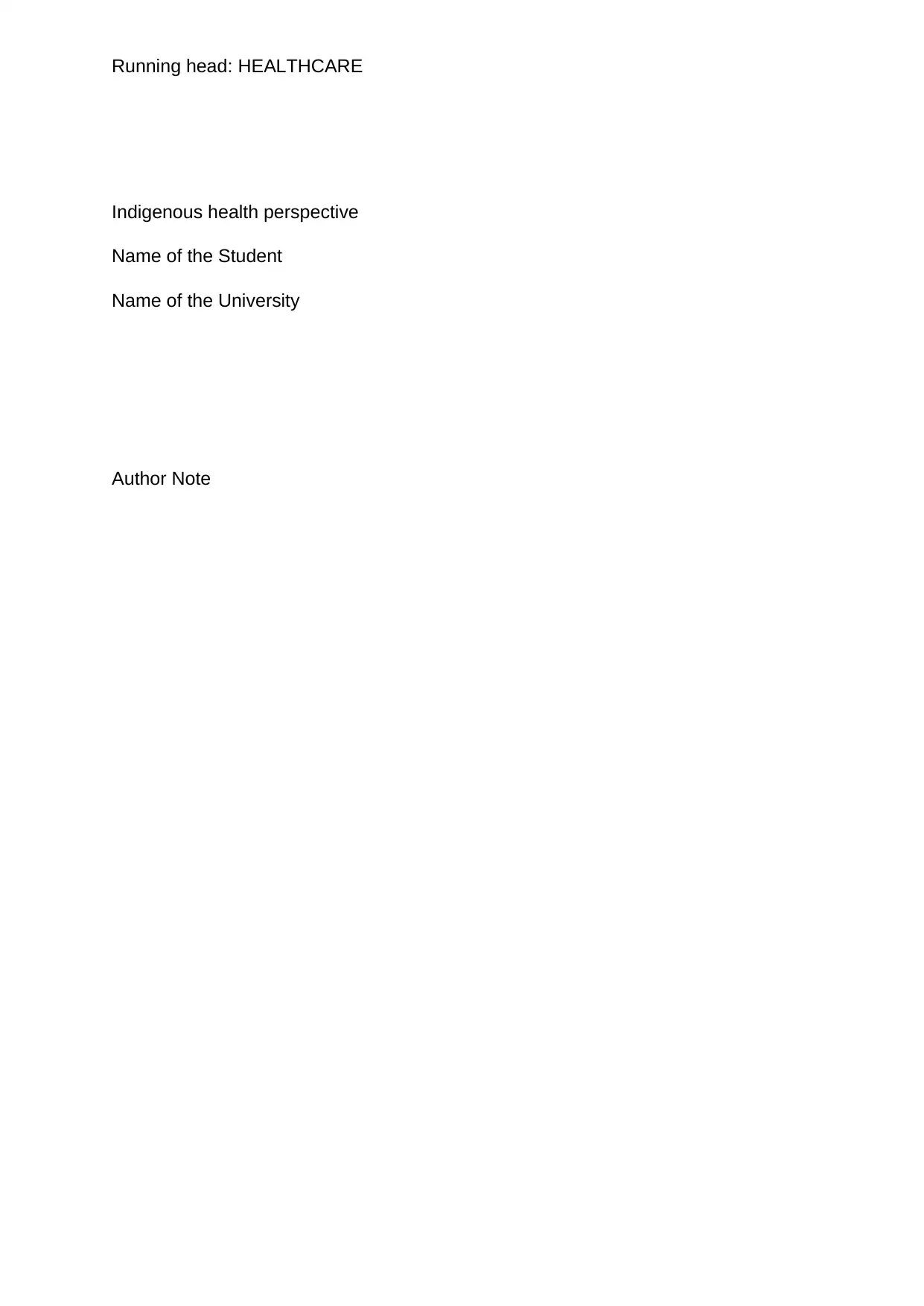
Running head: HEALTHCARE
Indigenous health perspective
Name of the Student
Name of the University
Author Note
Indigenous health perspective
Name of the Student
Name of the University
Author Note
Secure Best Marks with AI Grader
Need help grading? Try our AI Grader for instant feedback on your assignments.

1HEALTHCARE
Introduction- The term indigenous Australians is an umbrella term that refers
to the Aboriginal and Torres Strait Islander inhabitants of Australia, who descended
from communities that resided in Australia and adjacent island, prior to the British
colonisation (Waterworth, Dimmock, Pescud, Braham & Rosenberg, 2016). Recent
reports from the government provide an evidence for the fact that indigenous
Australians have been found to be twice more likely to have poor health outcomes,
and also manifest an increased likelihood of suffering from different long-term health
conditions such as, cardiovascular problems, renal impairment, mental health issues,
and communicable diseases, following adjustment of demographic structures (Willis,
Reynolds & Keleher, 2016). This essay will elaborate on an indigenous health
service organisation, and identify particular practices and factors that influenced its
development.
Profile- Danila Dilba Health Service (DDHS) is a prominent Aboriginal
community-governed organisation that aims to deliver culturally-appropriate and all-
inclusive community and primary healthcare services to the indigenous Biluru
people, residing in Yilli Rreung part of the Northern Territory. The name Danila Dilba
was agreed upon by the Larrakia individuals, who have been identified as the
traditional proprietors of Darwin and Palmerston. The name commonly stands for
‘dilly bag that helps in collecting bush medicines’ (Ddhs.org.au, 2019). Danila Dilba
was initially formulated in the form of a community regulated Aboriginal healthcare
service in early 70s. Following the cyclone Tracy in 1974, indigenous persons were
displaced to southern cities that had few Aboriginal medical services. This
encouraged the proprietors to establish the DDHS.
There is mounting evidence for the fact that some of the largest identifiable
and avoidable contributors to poor indigenous health outcomes that directly increase
the burden of illness in Australia are alcohol, tobacco, illicit drugs, insufficient
physical activity, increased body mass, elevated blood pressure, low consumption of
fruit and vegetables, increased cholesterol, child sexual abuse, unsafe
sex, and partner violence (Muller, 2014). Time and again it has been found that the
Aboriginal and Torres Strait Islander individuals display an impaired physical health
and psychological suffering that non-indigenous persons (Panaretto, Wenitong,
Button & Ring, 2014). Widespread loss and grief in the target population due to loss
of connection, culture and invasion history is one major risk factor for poor mental
Introduction- The term indigenous Australians is an umbrella term that refers
to the Aboriginal and Torres Strait Islander inhabitants of Australia, who descended
from communities that resided in Australia and adjacent island, prior to the British
colonisation (Waterworth, Dimmock, Pescud, Braham & Rosenberg, 2016). Recent
reports from the government provide an evidence for the fact that indigenous
Australians have been found to be twice more likely to have poor health outcomes,
and also manifest an increased likelihood of suffering from different long-term health
conditions such as, cardiovascular problems, renal impairment, mental health issues,
and communicable diseases, following adjustment of demographic structures (Willis,
Reynolds & Keleher, 2016). This essay will elaborate on an indigenous health
service organisation, and identify particular practices and factors that influenced its
development.
Profile- Danila Dilba Health Service (DDHS) is a prominent Aboriginal
community-governed organisation that aims to deliver culturally-appropriate and all-
inclusive community and primary healthcare services to the indigenous Biluru
people, residing in Yilli Rreung part of the Northern Territory. The name Danila Dilba
was agreed upon by the Larrakia individuals, who have been identified as the
traditional proprietors of Darwin and Palmerston. The name commonly stands for
‘dilly bag that helps in collecting bush medicines’ (Ddhs.org.au, 2019). Danila Dilba
was initially formulated in the form of a community regulated Aboriginal healthcare
service in early 70s. Following the cyclone Tracy in 1974, indigenous persons were
displaced to southern cities that had few Aboriginal medical services. This
encouraged the proprietors to establish the DDHS.
There is mounting evidence for the fact that some of the largest identifiable
and avoidable contributors to poor indigenous health outcomes that directly increase
the burden of illness in Australia are alcohol, tobacco, illicit drugs, insufficient
physical activity, increased body mass, elevated blood pressure, low consumption of
fruit and vegetables, increased cholesterol, child sexual abuse, unsafe
sex, and partner violence (Muller, 2014). Time and again it has been found that the
Aboriginal and Torres Strait Islander individuals display an impaired physical health
and psychological suffering that non-indigenous persons (Panaretto, Wenitong,
Button & Ring, 2014). Widespread loss and grief in the target population due to loss
of connection, culture and invasion history is one major risk factor for poor mental
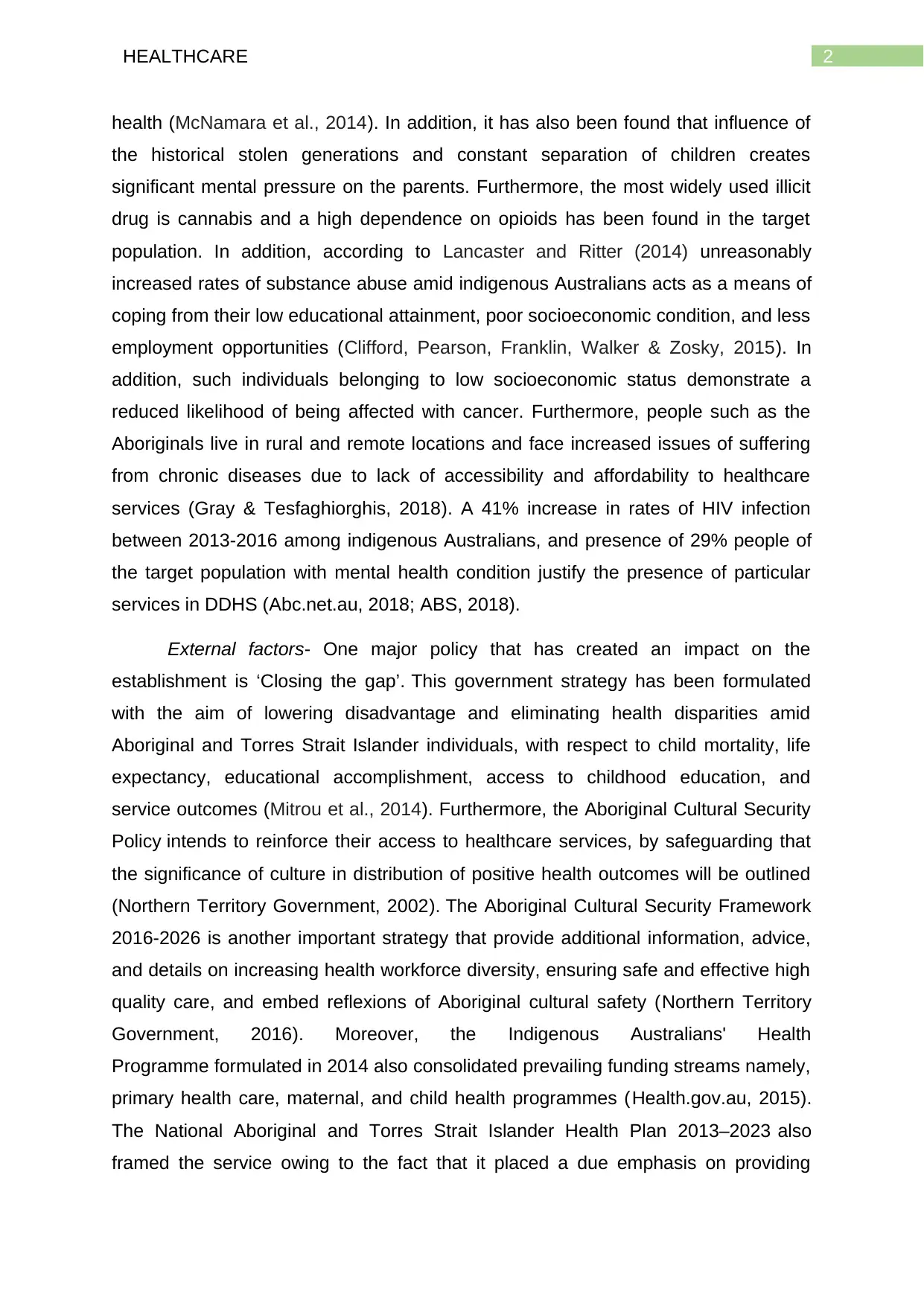
2HEALTHCARE
health (McNamara et al., 2014). In addition, it has also been found that influence of
the historical stolen generations and constant separation of children creates
significant mental pressure on the parents. Furthermore, the most widely used illicit
drug is cannabis and a high dependence on opioids has been found in the target
population. In addition, according to Lancaster and Ritter (2014) unreasonably
increased rates of substance abuse amid indigenous Australians acts as a means of
coping from their low educational attainment, poor socioeconomic condition, and less
employment opportunities (Clifford, Pearson, Franklin, Walker & Zosky, 2015). In
addition, such individuals belonging to low socioeconomic status demonstrate a
reduced likelihood of being affected with cancer. Furthermore, people such as the
Aboriginals live in rural and remote locations and face increased issues of suffering
from chronic diseases due to lack of accessibility and affordability to healthcare
services (Gray & Tesfaghiorghis, 2018). A 41% increase in rates of HIV infection
between 2013-2016 among indigenous Australians, and presence of 29% people of
the target population with mental health condition justify the presence of particular
services in DDHS (Abc.net.au, 2018; ABS, 2018).
External factors- One major policy that has created an impact on the
establishment is ‘Closing the gap’. This government strategy has been formulated
with the aim of lowering disadvantage and eliminating health disparities amid
Aboriginal and Torres Strait Islander individuals, with respect to child mortality, life
expectancy, educational accomplishment, access to childhood education, and
service outcomes (Mitrou et al., 2014). Furthermore, the Aboriginal Cultural Security
Policy intends to reinforce their access to healthcare services, by safeguarding that
the significance of culture in distribution of positive health outcomes will be outlined
(Northern Territory Government, 2002). The Aboriginal Cultural Security Framework
2016-2026 is another important strategy that provide additional information, advice,
and details on increasing health workforce diversity, ensuring safe and effective high
quality care, and embed reflexions of Aboriginal cultural safety (Northern Territory
Government, 2016). Moreover, the Indigenous Australians' Health
Programme formulated in 2014 also consolidated prevailing funding streams namely,
primary health care, maternal, and child health programmes (Health.gov.au, 2015).
The National Aboriginal and Torres Strait Islander Health Plan 2013–2023 also
framed the service owing to the fact that it placed a due emphasis on providing
health (McNamara et al., 2014). In addition, it has also been found that influence of
the historical stolen generations and constant separation of children creates
significant mental pressure on the parents. Furthermore, the most widely used illicit
drug is cannabis and a high dependence on opioids has been found in the target
population. In addition, according to Lancaster and Ritter (2014) unreasonably
increased rates of substance abuse amid indigenous Australians acts as a means of
coping from their low educational attainment, poor socioeconomic condition, and less
employment opportunities (Clifford, Pearson, Franklin, Walker & Zosky, 2015). In
addition, such individuals belonging to low socioeconomic status demonstrate a
reduced likelihood of being affected with cancer. Furthermore, people such as the
Aboriginals live in rural and remote locations and face increased issues of suffering
from chronic diseases due to lack of accessibility and affordability to healthcare
services (Gray & Tesfaghiorghis, 2018). A 41% increase in rates of HIV infection
between 2013-2016 among indigenous Australians, and presence of 29% people of
the target population with mental health condition justify the presence of particular
services in DDHS (Abc.net.au, 2018; ABS, 2018).
External factors- One major policy that has created an impact on the
establishment is ‘Closing the gap’. This government strategy has been formulated
with the aim of lowering disadvantage and eliminating health disparities amid
Aboriginal and Torres Strait Islander individuals, with respect to child mortality, life
expectancy, educational accomplishment, access to childhood education, and
service outcomes (Mitrou et al., 2014). Furthermore, the Aboriginal Cultural Security
Policy intends to reinforce their access to healthcare services, by safeguarding that
the significance of culture in distribution of positive health outcomes will be outlined
(Northern Territory Government, 2002). The Aboriginal Cultural Security Framework
2016-2026 is another important strategy that provide additional information, advice,
and details on increasing health workforce diversity, ensuring safe and effective high
quality care, and embed reflexions of Aboriginal cultural safety (Northern Territory
Government, 2016). Moreover, the Indigenous Australians' Health
Programme formulated in 2014 also consolidated prevailing funding streams namely,
primary health care, maternal, and child health programmes (Health.gov.au, 2015).
The National Aboriginal and Torres Strait Islander Health Plan 2013–2023 also
framed the service owing to the fact that it placed a due emphasis on providing
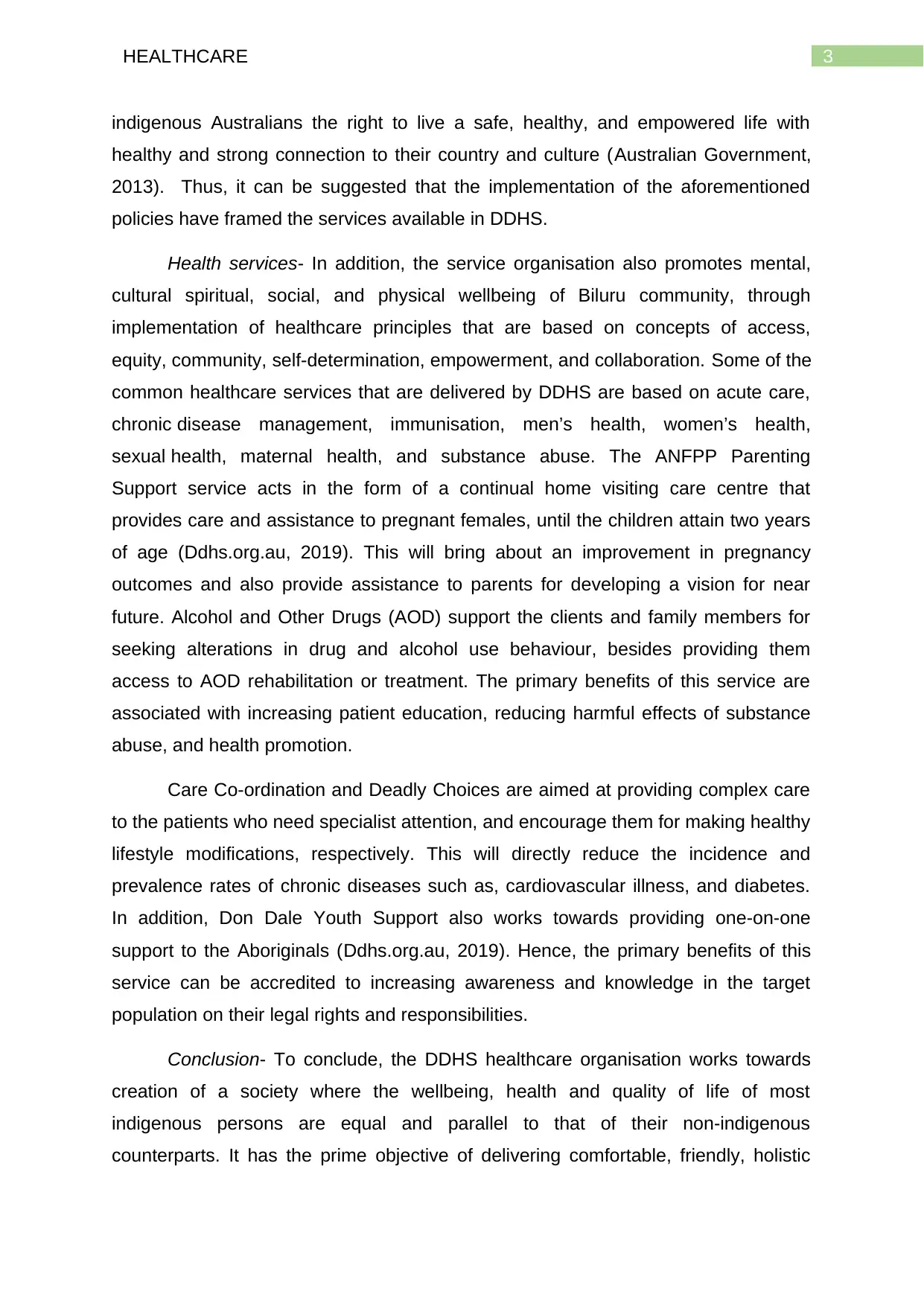
3HEALTHCARE
indigenous Australians the right to live a safe, healthy, and empowered life with
healthy and strong connection to their country and culture (Australian Government,
2013). Thus, it can be suggested that the implementation of the aforementioned
policies have framed the services available in DDHS.
Health services- In addition, the service organisation also promotes mental,
cultural spiritual, social, and physical wellbeing of Biluru community, through
implementation of healthcare principles that are based on concepts of access,
equity, community, self-determination, empowerment, and collaboration. Some of the
common healthcare services that are delivered by DDHS are based on acute care,
chronic disease management, immunisation, men’s health, women’s health,
sexual health, maternal health, and substance abuse. The ANFPP Parenting
Support service acts in the form of a continual home visiting care centre that
provides care and assistance to pregnant females, until the children attain two years
of age (Ddhs.org.au, 2019). This will bring about an improvement in pregnancy
outcomes and also provide assistance to parents for developing a vision for near
future. Alcohol and Other Drugs (AOD) support the clients and family members for
seeking alterations in drug and alcohol use behaviour, besides providing them
access to AOD rehabilitation or treatment. The primary benefits of this service are
associated with increasing patient education, reducing harmful effects of substance
abuse, and health promotion.
Care Co-ordination and Deadly Choices are aimed at providing complex care
to the patients who need specialist attention, and encourage them for making healthy
lifestyle modifications, respectively. This will directly reduce the incidence and
prevalence rates of chronic diseases such as, cardiovascular illness, and diabetes.
In addition, Don Dale Youth Support also works towards providing one-on-one
support to the Aboriginals (Ddhs.org.au, 2019). Hence, the primary benefits of this
service can be accredited to increasing awareness and knowledge in the target
population on their legal rights and responsibilities.
Conclusion- To conclude, the DDHS healthcare organisation works towards
creation of a society where the wellbeing, health and quality of life of most
indigenous persons are equal and parallel to that of their non-indigenous
counterparts. It has the prime objective of delivering comfortable, friendly, holistic
indigenous Australians the right to live a safe, healthy, and empowered life with
healthy and strong connection to their country and culture (Australian Government,
2013). Thus, it can be suggested that the implementation of the aforementioned
policies have framed the services available in DDHS.
Health services- In addition, the service organisation also promotes mental,
cultural spiritual, social, and physical wellbeing of Biluru community, through
implementation of healthcare principles that are based on concepts of access,
equity, community, self-determination, empowerment, and collaboration. Some of the
common healthcare services that are delivered by DDHS are based on acute care,
chronic disease management, immunisation, men’s health, women’s health,
sexual health, maternal health, and substance abuse. The ANFPP Parenting
Support service acts in the form of a continual home visiting care centre that
provides care and assistance to pregnant females, until the children attain two years
of age (Ddhs.org.au, 2019). This will bring about an improvement in pregnancy
outcomes and also provide assistance to parents for developing a vision for near
future. Alcohol and Other Drugs (AOD) support the clients and family members for
seeking alterations in drug and alcohol use behaviour, besides providing them
access to AOD rehabilitation or treatment. The primary benefits of this service are
associated with increasing patient education, reducing harmful effects of substance
abuse, and health promotion.
Care Co-ordination and Deadly Choices are aimed at providing complex care
to the patients who need specialist attention, and encourage them for making healthy
lifestyle modifications, respectively. This will directly reduce the incidence and
prevalence rates of chronic diseases such as, cardiovascular illness, and diabetes.
In addition, Don Dale Youth Support also works towards providing one-on-one
support to the Aboriginals (Ddhs.org.au, 2019). Hence, the primary benefits of this
service can be accredited to increasing awareness and knowledge in the target
population on their legal rights and responsibilities.
Conclusion- To conclude, the DDHS healthcare organisation works towards
creation of a society where the wellbeing, health and quality of life of most
indigenous persons are equal and parallel to that of their non-indigenous
counterparts. It has the prime objective of delivering comfortable, friendly, holistic
Secure Best Marks with AI Grader
Need help grading? Try our AI Grader for instant feedback on your assignments.
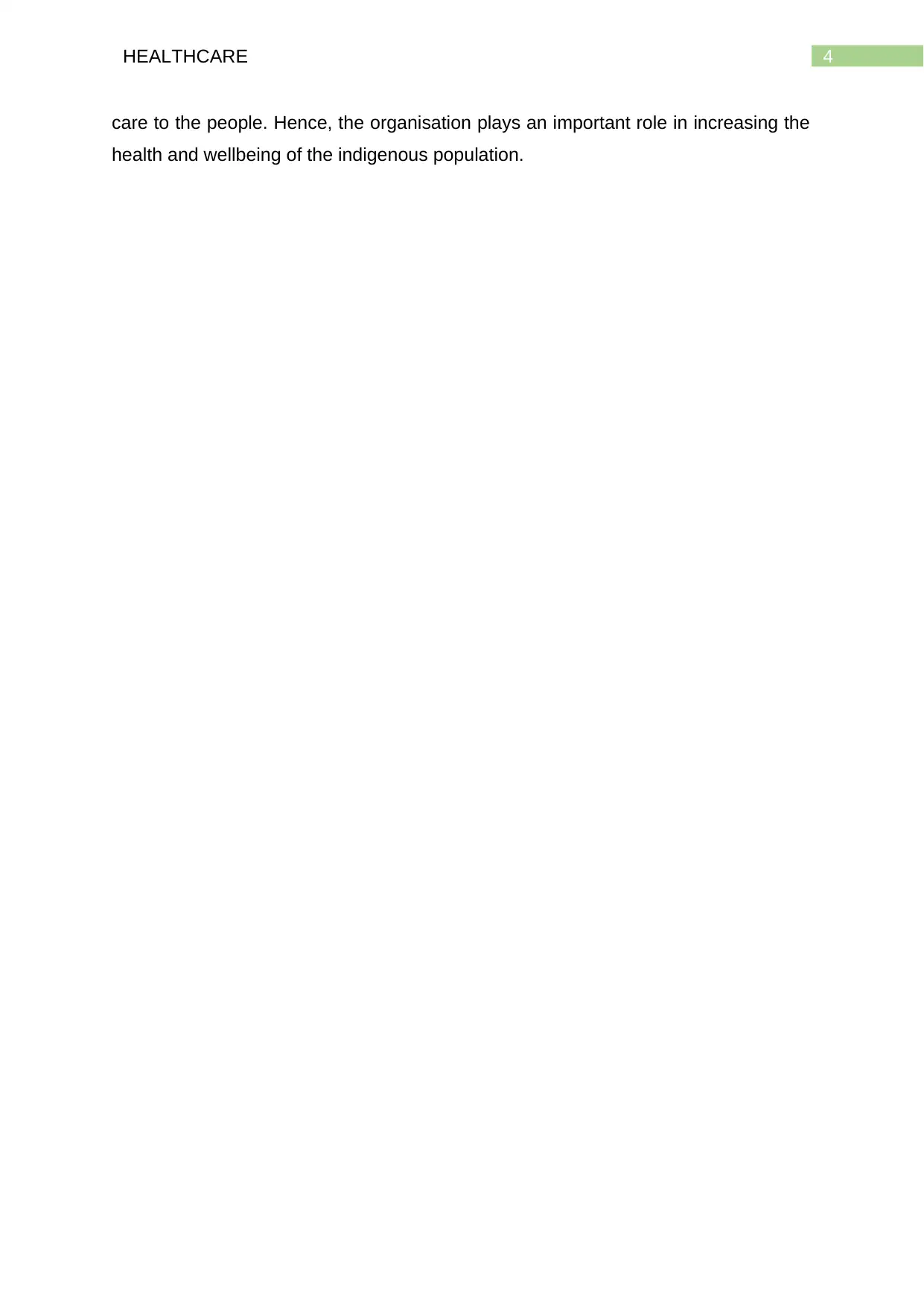
4HEALTHCARE
care to the people. Hence, the organisation plays an important role in increasing the
health and wellbeing of the indigenous population.
care to the people. Hence, the organisation plays an important role in increasing the
health and wellbeing of the indigenous population.
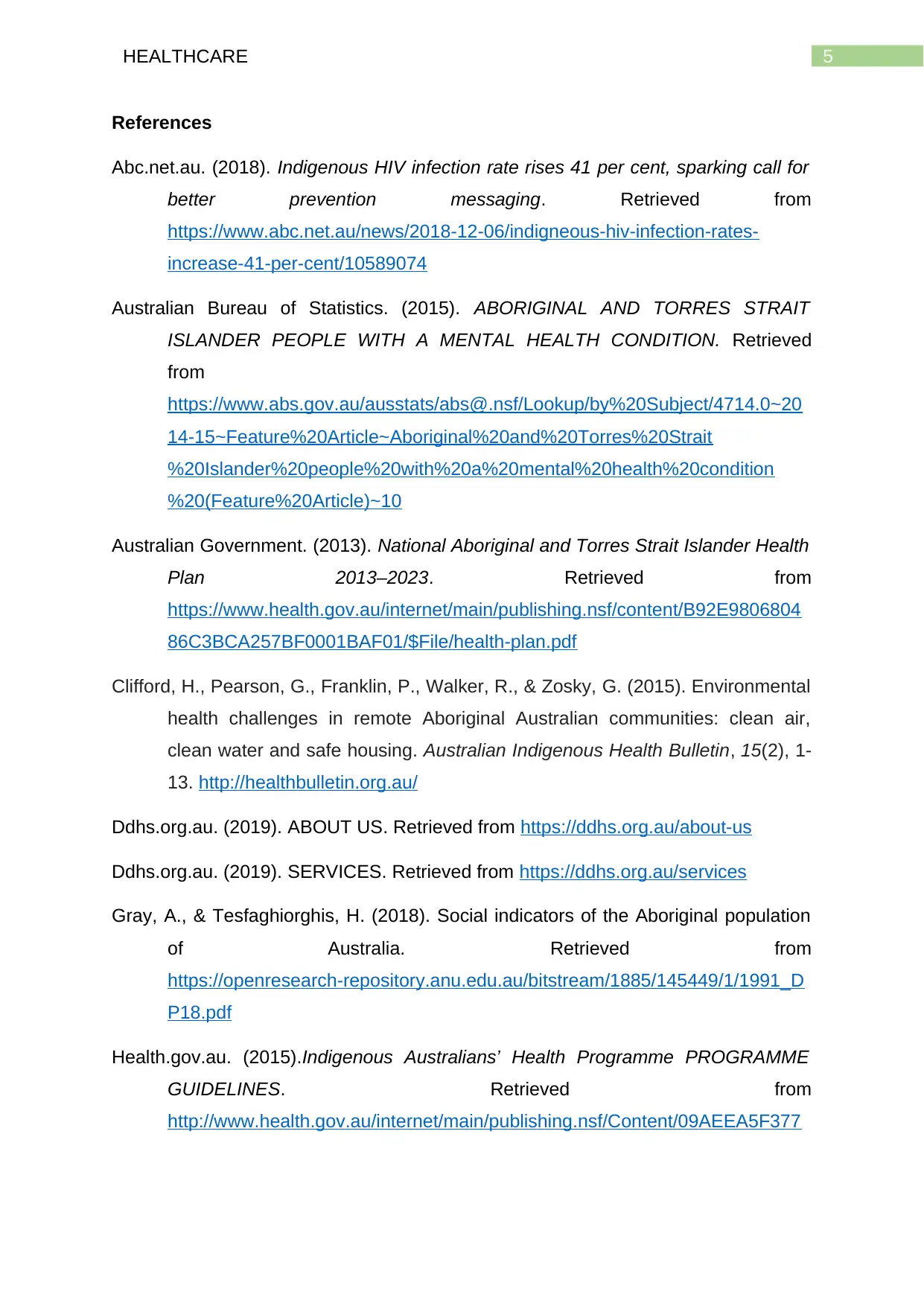
5HEALTHCARE
References
Abc.net.au. (2018). Indigenous HIV infection rate rises 41 per cent, sparking call for
better prevention messaging. Retrieved from
https://www.abc.net.au/news/2018-12-06/indigneous-hiv-infection-rates-
increase-41-per-cent/10589074
Australian Bureau of Statistics. (2015). ABORIGINAL AND TORRES STRAIT
ISLANDER PEOPLE WITH A MENTAL HEALTH CONDITION. Retrieved
from
https://www.abs.gov.au/ausstats/abs@.nsf/Lookup/by%20Subject/4714.0~20
14-15~Feature%20Article~Aboriginal%20and%20Torres%20Strait
%20Islander%20people%20with%20a%20mental%20health%20condition
%20(Feature%20Article)~10
Australian Government. (2013). National Aboriginal and Torres Strait Islander Health
Plan 2013–2023. Retrieved from
https://www.health.gov.au/internet/main/publishing.nsf/content/B92E9806804
86C3BCA257BF0001BAF01/$File/health-plan.pdf
Clifford, H., Pearson, G., Franklin, P., Walker, R., & Zosky, G. (2015). Environmental
health challenges in remote Aboriginal Australian communities: clean air,
clean water and safe housing. Australian Indigenous Health Bulletin, 15(2), 1-
13. http://healthbulletin.org.au/
Ddhs.org.au. (2019). ABOUT US. Retrieved from https://ddhs.org.au/about-us
Ddhs.org.au. (2019). SERVICES. Retrieved from https://ddhs.org.au/services
Gray, A., & Tesfaghiorghis, H. (2018). Social indicators of the Aboriginal population
of Australia. Retrieved from
https://openresearch-repository.anu.edu.au/bitstream/1885/145449/1/1991_D
P18.pdf
Health.gov.au. (2015).Indigenous Australians’ Health Programme PROGRAMME
GUIDELINES. Retrieved from
http://www.health.gov.au/internet/main/publishing.nsf/Content/09AEEA5F377
References
Abc.net.au. (2018). Indigenous HIV infection rate rises 41 per cent, sparking call for
better prevention messaging. Retrieved from
https://www.abc.net.au/news/2018-12-06/indigneous-hiv-infection-rates-
increase-41-per-cent/10589074
Australian Bureau of Statistics. (2015). ABORIGINAL AND TORRES STRAIT
ISLANDER PEOPLE WITH A MENTAL HEALTH CONDITION. Retrieved
from
https://www.abs.gov.au/ausstats/abs@.nsf/Lookup/by%20Subject/4714.0~20
14-15~Feature%20Article~Aboriginal%20and%20Torres%20Strait
%20Islander%20people%20with%20a%20mental%20health%20condition
%20(Feature%20Article)~10
Australian Government. (2013). National Aboriginal and Torres Strait Islander Health
Plan 2013–2023. Retrieved from
https://www.health.gov.au/internet/main/publishing.nsf/content/B92E9806804
86C3BCA257BF0001BAF01/$File/health-plan.pdf
Clifford, H., Pearson, G., Franklin, P., Walker, R., & Zosky, G. (2015). Environmental
health challenges in remote Aboriginal Australian communities: clean air,
clean water and safe housing. Australian Indigenous Health Bulletin, 15(2), 1-
13. http://healthbulletin.org.au/
Ddhs.org.au. (2019). ABOUT US. Retrieved from https://ddhs.org.au/about-us
Ddhs.org.au. (2019). SERVICES. Retrieved from https://ddhs.org.au/services
Gray, A., & Tesfaghiorghis, H. (2018). Social indicators of the Aboriginal population
of Australia. Retrieved from
https://openresearch-repository.anu.edu.au/bitstream/1885/145449/1/1991_D
P18.pdf
Health.gov.au. (2015).Indigenous Australians’ Health Programme PROGRAMME
GUIDELINES. Retrieved from
http://www.health.gov.au/internet/main/publishing.nsf/Content/09AEEA5F377
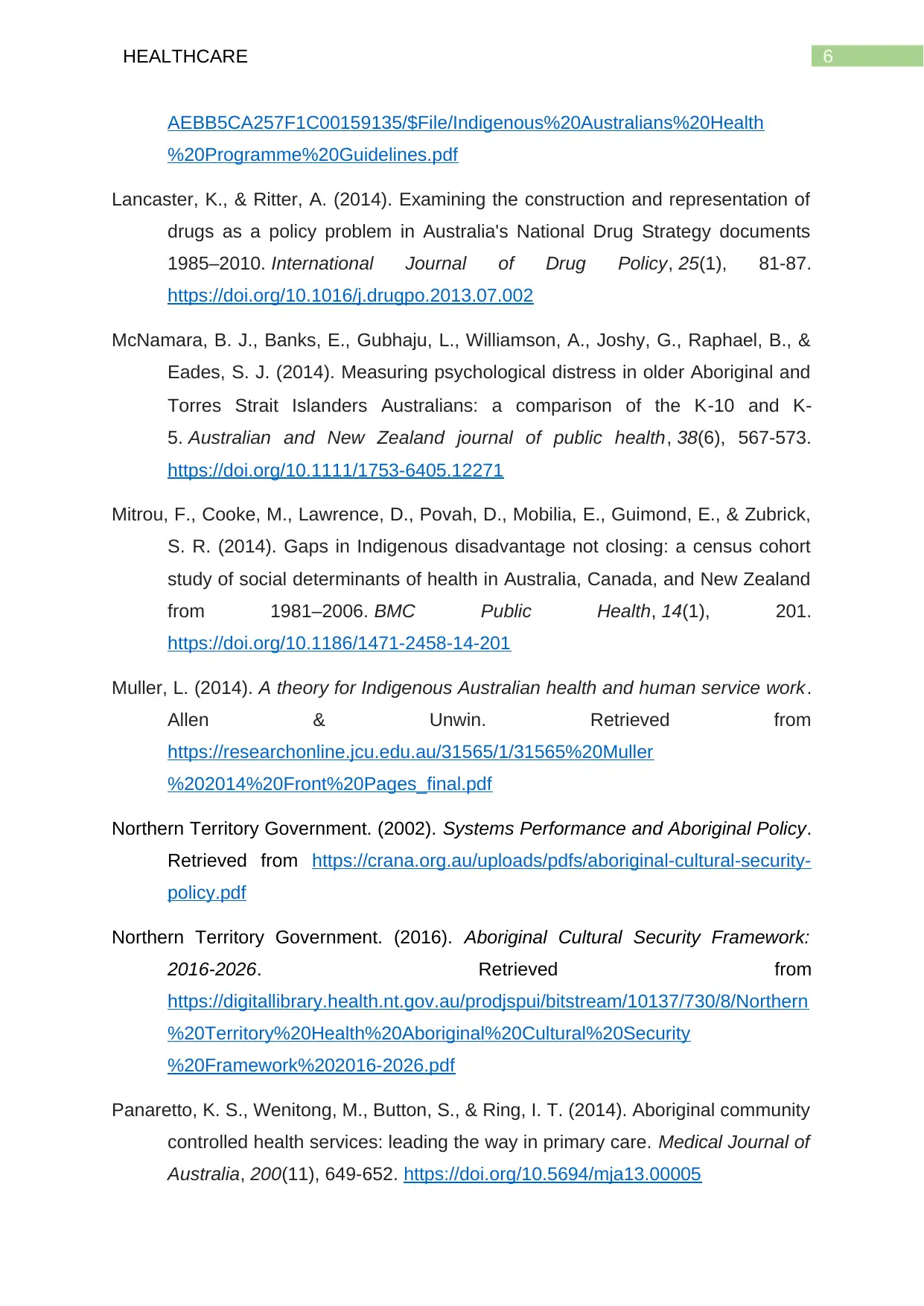
6HEALTHCARE
AEBB5CA257F1C00159135/$File/Indigenous%20Australians%20Health
%20Programme%20Guidelines.pdf
Lancaster, K., & Ritter, A. (2014). Examining the construction and representation of
drugs as a policy problem in Australia's National Drug Strategy documents
1985–2010. International Journal of Drug Policy, 25(1), 81-87.
https://doi.org/10.1016/j.drugpo.2013.07.002
McNamara, B. J., Banks, E., Gubhaju, L., Williamson, A., Joshy, G., Raphael, B., &
Eades, S. J. (2014). Measuring psychological distress in older Aboriginal and
Torres Strait Islanders Australians: a comparison of the K‐10 and K‐
5. Australian and New Zealand journal of public health, 38(6), 567-573.
https://doi.org/10.1111/1753-6405.12271
Mitrou, F., Cooke, M., Lawrence, D., Povah, D., Mobilia, E., Guimond, E., & Zubrick,
S. R. (2014). Gaps in Indigenous disadvantage not closing: a census cohort
study of social determinants of health in Australia, Canada, and New Zealand
from 1981–2006. BMC Public Health, 14(1), 201.
https://doi.org/10.1186/1471-2458-14-201
Muller, L. (2014). A theory for Indigenous Australian health and human service work.
Allen & Unwin. Retrieved from
https://researchonline.jcu.edu.au/31565/1/31565%20Muller
%202014%20Front%20Pages_final.pdf
Northern Territory Government. (2002). Systems Performance and Aboriginal Policy.
Retrieved from https://crana.org.au/uploads/pdfs/aboriginal-cultural-security-
policy.pdf
Northern Territory Government. (2016). Aboriginal Cultural Security Framework:
2016-2026. Retrieved from
https://digitallibrary.health.nt.gov.au/prodjspui/bitstream/10137/730/8/Northern
%20Territory%20Health%20Aboriginal%20Cultural%20Security
%20Framework%202016-2026.pdf
Panaretto, K. S., Wenitong, M., Button, S., & Ring, I. T. (2014). Aboriginal community
controlled health services: leading the way in primary care. Medical Journal of
Australia, 200(11), 649-652. https://doi.org/10.5694/mja13.00005
AEBB5CA257F1C00159135/$File/Indigenous%20Australians%20Health
%20Programme%20Guidelines.pdf
Lancaster, K., & Ritter, A. (2014). Examining the construction and representation of
drugs as a policy problem in Australia's National Drug Strategy documents
1985–2010. International Journal of Drug Policy, 25(1), 81-87.
https://doi.org/10.1016/j.drugpo.2013.07.002
McNamara, B. J., Banks, E., Gubhaju, L., Williamson, A., Joshy, G., Raphael, B., &
Eades, S. J. (2014). Measuring psychological distress in older Aboriginal and
Torres Strait Islanders Australians: a comparison of the K‐10 and K‐
5. Australian and New Zealand journal of public health, 38(6), 567-573.
https://doi.org/10.1111/1753-6405.12271
Mitrou, F., Cooke, M., Lawrence, D., Povah, D., Mobilia, E., Guimond, E., & Zubrick,
S. R. (2014). Gaps in Indigenous disadvantage not closing: a census cohort
study of social determinants of health in Australia, Canada, and New Zealand
from 1981–2006. BMC Public Health, 14(1), 201.
https://doi.org/10.1186/1471-2458-14-201
Muller, L. (2014). A theory for Indigenous Australian health and human service work.
Allen & Unwin. Retrieved from
https://researchonline.jcu.edu.au/31565/1/31565%20Muller
%202014%20Front%20Pages_final.pdf
Northern Territory Government. (2002). Systems Performance and Aboriginal Policy.
Retrieved from https://crana.org.au/uploads/pdfs/aboriginal-cultural-security-
policy.pdf
Northern Territory Government. (2016). Aboriginal Cultural Security Framework:
2016-2026. Retrieved from
https://digitallibrary.health.nt.gov.au/prodjspui/bitstream/10137/730/8/Northern
%20Territory%20Health%20Aboriginal%20Cultural%20Security
%20Framework%202016-2026.pdf
Panaretto, K. S., Wenitong, M., Button, S., & Ring, I. T. (2014). Aboriginal community
controlled health services: leading the way in primary care. Medical Journal of
Australia, 200(11), 649-652. https://doi.org/10.5694/mja13.00005
Paraphrase This Document
Need a fresh take? Get an instant paraphrase of this document with our AI Paraphraser
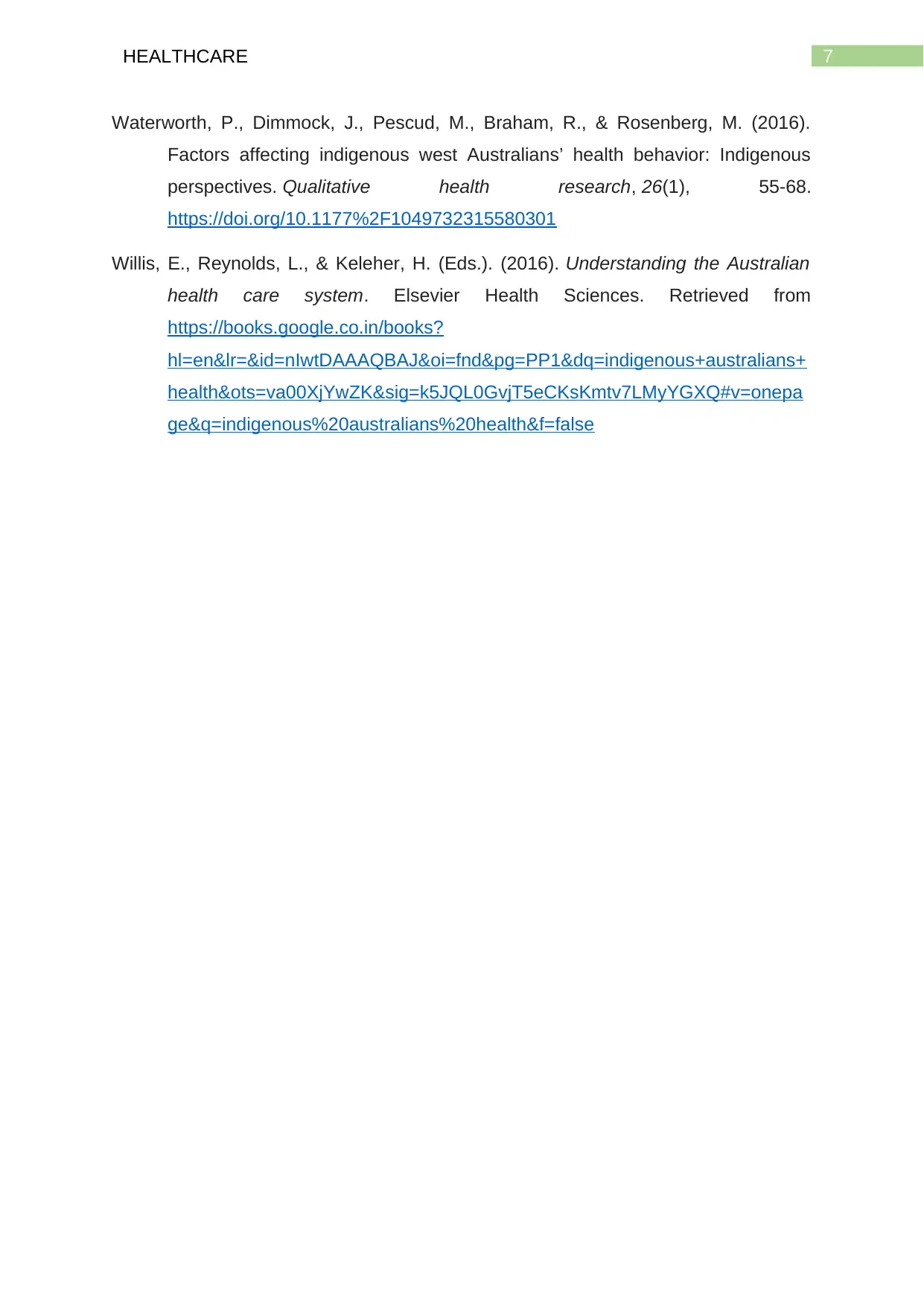
7HEALTHCARE
Waterworth, P., Dimmock, J., Pescud, M., Braham, R., & Rosenberg, M. (2016).
Factors affecting indigenous west Australians’ health behavior: Indigenous
perspectives. Qualitative health research, 26(1), 55-68.
https://doi.org/10.1177%2F1049732315580301
Willis, E., Reynolds, L., & Keleher, H. (Eds.). (2016). Understanding the Australian
health care system. Elsevier Health Sciences. Retrieved from
https://books.google.co.in/books?
hl=en&lr=&id=nIwtDAAAQBAJ&oi=fnd&pg=PP1&dq=indigenous+australians+
health&ots=va00XjYwZK&sig=k5JQL0GvjT5eCKsKmtv7LMyYGXQ#v=onepa
ge&q=indigenous%20australians%20health&f=false
Waterworth, P., Dimmock, J., Pescud, M., Braham, R., & Rosenberg, M. (2016).
Factors affecting indigenous west Australians’ health behavior: Indigenous
perspectives. Qualitative health research, 26(1), 55-68.
https://doi.org/10.1177%2F1049732315580301
Willis, E., Reynolds, L., & Keleher, H. (Eds.). (2016). Understanding the Australian
health care system. Elsevier Health Sciences. Retrieved from
https://books.google.co.in/books?
hl=en&lr=&id=nIwtDAAAQBAJ&oi=fnd&pg=PP1&dq=indigenous+australians+
health&ots=va00XjYwZK&sig=k5JQL0GvjT5eCKsKmtv7LMyYGXQ#v=onepa
ge&q=indigenous%20australians%20health&f=false
1 out of 8
Related Documents
Your All-in-One AI-Powered Toolkit for Academic Success.
+13062052269
info@desklib.com
Available 24*7 on WhatsApp / Email
![[object Object]](/_next/static/media/star-bottom.7253800d.svg)
Unlock your academic potential
© 2024 | Zucol Services PVT LTD | All rights reserved.





